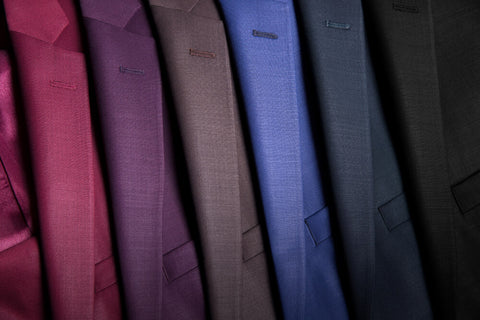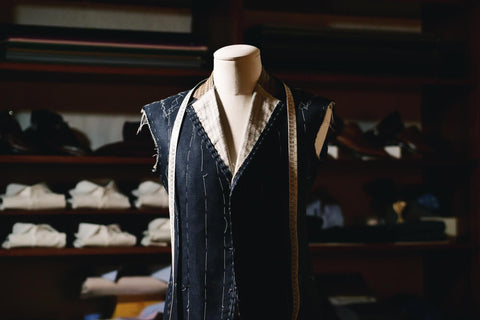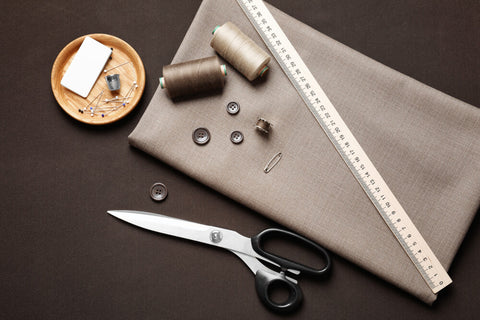
What Is Suit Fabric?
The secret to a great suit lies in the fabric selection. From wool to cotton, linen to tweed, the options are endless. These carefully chosen suit fabrics determine not only the style and function but also the quality and personality of the garment. A true tailor knows that the right fabric can make all the difference.
A suit is more than just an outfit; it's a symbol of style and sophistication. The materials used to craft a suit are just as crucial as the design itself and should be chosen with care.
Your suit is a reflection of your taste and character, so don't settle for anything less than the best.
What Is Suit Fabric Used For?
Put simply, suit fabrics are the materials used to create suits. However, the individual materials themselves such as cotton, silk, wool and other fibres are the fundamental building blocks of every garment you can't think of.
In essence ‘suit fabrics’ encompasses almost all fabrics - which are present in almost all garments - however, for this blog, we will be focusing on the tailoring of suits.
What Can You Make With Suit Fabrics?
Suit fabrics are expertly woven by specialist tailors to make amazing suits and tailored garments for both men and women. Using suit fabrics tailors can make trousers, blazers waistcoats and even headwear and can achieve various stunning styles depending on the suit material used.
Tailors can create some truly amazing garments and suits that have a unique feel, weight and shape that can capture the personality of an individual. What’s more, no suit is complete without its accompanying handkerchief typically created using a matching suit fabric to really tie the look together.

What Do Suit Fabrics Feel Like?
Generally speaking, most suit fabrics are woven with comfort in mind and are lightweight as well as breathable.
Most cloths used to make suits, such as linen, are soft to the touch and are perfectly suited for mild and warmer weather conditions. However, it's not uncommon for suit materials, such as worsted wool, to have tight fibres - giving a smoother finish whilst also being thicker and heavier.
Different Types Of Suit Fabrics
With continuous advancements in fabric-making technology, the materials and cloth used to make suits are nearly endless. However, for the sake of this blog, we will focus on the most popular choices for suit makers and tailors.
- Wool fabric — Wool is a breathable, soft and wrinkle-resistant fabric that is the top pick for suit makers. There are various different types of wool that can be used to make a suit, these are worsted, tweed merino and cashmere. However, a drawback of wool is that it tends to be bulky and doesn’t age as well as other suit fabrics.
-
Viscose fabric — A semi-synthetic fibre made from cellulose, viscose gives the same luxurious look as silk without the eye watering price tag. However, viscose fabric creases easily and has poor humidity absorption.
- Cotton fabric — Another plant-based suit material, cotton is breathable and flexible and moves with your body.
- Linen fabric — Linen is another natural suit material that is lightweight and breathable. But the downside is that this fabric stains easily and is better suited for warmer weather.
- Velvet fabric — Although velvet is a type of weaving technique, it can be used to achieve a stunning and luxurious look to suit fabrics. Making it a perfect choice for special occasions.
- Silk fabric — Silk is created from animal proteins being woven into textiles. This suiting fabric is breathable and temperature regulated, making it an ideal choice for any weather condition.
- Polyester fabric — A synthetic fabric that is often used by suit makers due to its low price, durable quality and lightweight feel. However, polyester is not breathable and is better suited for mild weather.

All the tools a master tailor would need to create stunning suits and garments.
Are Suit Fabrics Eco-Friendly?
Most suit fabrics can be considered to be eco-friendly due to their organic origin. With the likes of linen, Viscose and cotton coming from plant-based origins and the likes of wool and silk from animals.
However, the argument on whether these fabrics are environmentally friendly lies in the farming practices used.
The likes of cotton require a heavy amount of land, pesticides and thousands of gallons of water to grow and do a lot more harm to the environment than most people realise. However it is not all bad - there are sustainably grown suit fabrics such as linen which is biodegradable and requires less land and pesticide to grow, but will often come with an eye-watering price tag.
The argument on whether suit fabrics are eco-friendly is based entirely on the type of fabric you decide to go with to make your garments.
FAQs
What are the best fabrics for suits?
The best fabrics for suits are typically made from natural fibres like wool, cashmere, and silk. These materials are not only comfortable but also durable, breathable, and easy to maintain.
Wool is especially popular due to its versatility, as it can be worn year-round and comes in a range of weights and textures. Cashmere is known for its luxurious feel, while silk adds a touch of elegance and sheen to the fabric.
What are the different types of suit fabrics?
There is a wide variety of suit fabrics available, each with its unique qualities and benefits. Among the most common types are wool, cotton, linen, silk, and blends of synthetic materials.
Wool, which is a popular choice for its versatility and durability, comes in a range of weights and textures to suit different occasions and seasons. Cotton is prized for its softness and breathability, while linen is a great option for warm weather due to its light, airy texture. Silk, on the other hand, offers a luxurious look and feel with its elegant sheen. Finally, synthetic blends provide an affordable alternative with easy care and wrinkle resistance.
A brief history of suit fabrics.
The history of suit fabrics can be traced back to ancient civilizations like Egypt and Rome, where wealthy individuals adorned themselves in luxurious materials like silk and linen.
However, it wasn't until the 16th century that the modern suit as we know it began to take shape. Back then, wool was the primary material used for tailoring, and it remained the dominant fabric for centuries to come.
As manufacturing techniques improved and global trade flourished, other fabrics like cotton and silk became more accessible, allowing for greater variety and experimentation in the world of fashion.
Today, the suit continues to evolve with new materials and blends constantly being introduced, but it's clear that the fabrics used in suit-making have a rich and fascinating history that spans centuries.



2 comments
Thank you for this is very interesting blog .it has helped me find the right fabric for the suits I am making.